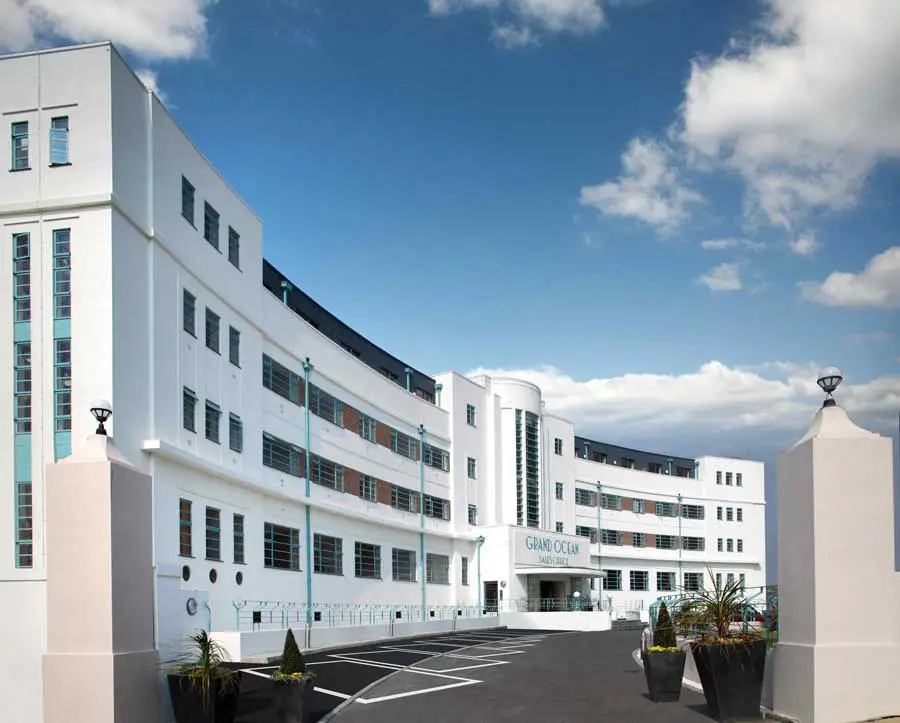Modern Brighton Buildings Tours, East Sussex Art Deco, Southern England Property Design News
Brighton Architecture
East Sussex Buildings: Modernist & Art Deco Developments in southern England, UK, Europe
31 Jan 2013
Brighton Architecture Tours
Modernist and deco landmarks feature strongly in first architectural tour of Brighton
Brighton Modernist & Art Deco Building
Ever since John Nash built the Prince Regent his extravagant Pavilion, Brighton has attracted architects seeking to push the boundaries of their craft. This has now been recognised in a new tour of the city’s landmark buildings which has been launched for 2013.
Explore Grand Ocean Brighton:
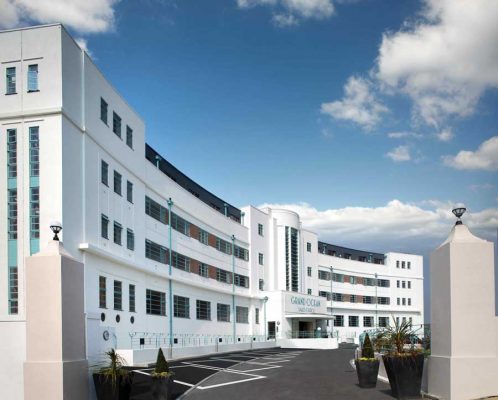
photo from Think BDW Ltd
Joining the well known Pavilion, Pier and the Regency splendour of Kemp Town are a collection of landmark twentieth century buildings. The tour begins at Saltdean on the eastern fringes of the city with the Grand Ocean building and the Saltdean Lido both designed by RWH Jones in 1938. The restored art deco Grand Ocean was formerly the Grand Hotel and is now converted to luxury apartments.
Brighton Pavilion:
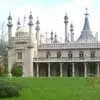
photo from Think BDW Ltd
Also included in the new tour are lesser-known but nonetheless important buildings in the history of the town and of architectural development since the Regency heyday of Brighton. The brooding presence of Rodean School designed by JW Simpson in 1899, William Glen’s 1930 Savoy Cinema, the original 18th century merchant houses of Ship Street and Wells Coates’ early modernist masterpiece, Embassy Court are all included on the new tour.
Embassy Court Brighton:
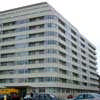
photo from Think BDW Ltd
The tour ends in Hove with the virtually unknown Barford Court at 157 Kingsway. An idiosyncratic Thirties villa built between 1934-7 by Robert Cromie for a northern steel tycoon.
John Carmichael, Marketing Manager at VisitBrighton says “Brighton & Hove has an amazing mix of architecture within its boundaries and this new self guided tour is a fantastic aid for any visitor or resident who is looking to explore the architectural styles of the city.”
Further details of the architectural tour of Brighton can be found at www.visitbrighton.com
Brighton Architecture Tour
Brighton & Hove Architectural Journey
This new tour takes you from Saltdean, across the city to the western area of Hove. It primarily looks at the city’s 20th century architectural legacy interspersed with some of more famous buildings from earlier periods, added Brighton architects Alter & Company.
Saltdean
Grand Ocean 1938 RWH Jones Moderne style designed as a luxury hotel for the charges of a moderate hotel; a symmetrical fan-shape. Taken over by Butlins in 1953 before its 21st century redevelopment into luxury apartments.
Saltdean Lido 1938 RWH Jones A similar design, a style reflecting the Thirties love of the streamline, and here the aeroplane, with curving wings and prominent central projection reflecting Bexhill’s De la Warr pavilion.
Rottingdean to the City Centre
Rottingdean Mill, a black timbered smock mill of 1802 denoting the areas agricultural heritage.
Ian Fraser House, more commonly named St. Dunstan’s, but now renamed Blind Veterans UK. A rehabilitation centre for blinded servicemen; heavily influenced by the Modern Movement and built in 1937, it has the aeroplane wings and central structure seen at Saltdean Lido
Roedean. Built in 1899 by JW Simpson in free Jacobean style an ambitious scheme combining educational and residential areas under one roof. This building replaced the earlier location of the school from nearby Kemp Town.
Marine Gate by Wimperis, Simpson & Guthrie, overlooking the Channel it has a nautical air with its port-hole windows.
Kemp Town
Beyond Marine Gate is the splendid Regency estate designed by Wilds & Busby for Thomas Read Kemp in 1825. The first example of Georgian town planning at the seaside,
Kemp Town, a spacious layout of large family homes that took 30 years from its inception before it achieved its present fame, leaving Kemp a bankrupt. The original appearance was as today, as the builders only erected the façade, with the purchasers having the house built behind!
Eastern seafront
The Van Allen Building 1999 by PRC Fewster, reflecting the Thirties architectural feel seen earlier; it has the curvilinear outline and stepped appearance of the Modernists.
Brighton [Palace] pier
This design is by R.St.George Moore, but heavily altered since. It is all that the seaside should be, fun and frolicsome, offering wonderful views of the Brighton & Hove coastline and extensive sea views. The history trail along the pier is worth following, look out for the old wrought and cast ironwork of the 19thcentury pier.
At this point it is possible to take a short detour away from the coast, inland to the Royal Pavilion estate and the Old Town.
Old Town
Brighton’s most famous and easily recognised building:
The Royal Pavilion; originally a town fringe farmhouse, it evolved into the Marine Pavilion, of George, Prince of Wales; an elegant, classically designed house, which by the 1820s had been transformed into the exotic Indian/Moorish influence palace of today. Its exuberant form has seeped out to many of the city’s buildings especially those along the prom and pier.
Within the Old Town near the foot of East St is the Savoy cinema 1930 by William Glen. A classic interwar super-cinema on the site of the 18th century Brills bathhouse. An impressive frontage with columns of ‘fasces’ the Roman punishment rods that came back into fashion via Mussolini’s Italy in the interwar period.
Nearby in Ship St. is the location of the 18th century resort’s merchants, substantial houses, many with bow fronts, Mathematical Tiles, local honey coloured brick and a variety of local flint work – from field and beach, cut, knapped, and boulder flints; many with fine doorways. Hotel du Vin at southern end is a glorious 1928 example of ‘Brewers Tudor’ by Ernest Barrow- jettied storeys, patterned brick, stained glass, carved oak beams and a portcullis.
Back on the coast road the way westward to Hove has Brighton’s usual 19th century collection of architecture with some blots of 20th century ‘leisure’! Three hotels stand out.
Seafront
The Grand Hotel by JWH Whichcord cost £57,000 in 1864; Italianate style of eight storeys, when opened it was the tallest structure in Europe and needed water powered lifts to enable access to the upper floors. Infamously bombed by the IRA in 1984 the rebuild has restored the Victorian swagger.
The Hotel Metropole of 1890, is a huge redbrick and terracotta edifice designed by Alfred Waterhouse who also designed the Natural History Museum in South Kensington
The Norfolk Hotel of 1865 by Horatio Goulty. Frothily Victorian, in imitation of grand London railway hotels, it forms the West End of resort Brighton.
Beyond here was the former parish boundary with Hove, the site of Brighton’s last detached seafront dwelling – Western House. Its demolition in 1931 was the starting point for the construction of one of Britain’s foremost Modern Movement buildings
Hove
Embassy Court 1935 by the Canadian architect Wells Coates; an example of early modernism, concrete framing, long unbroken bands of concrete between the windows and as balcony parapets. Twelve storeys, with the top floor set back and the curved south east corner it has all the features associated with the Modern Movement.
Immediately adjoining Embassy Court is a complete contrast: Brunswick Town, Hove; built from 1823 and one of the finest examples of Regency building anywhere; its uniform colour dictated by a 19th century Act of Parliament. This was the first of the major 19th century schemes to be promoted as family homes rather than as seasonal resort housing. It housed some of the greatest and good…and wealthiest, in the area.
Adjoining Brunswick Town is the almost contemporary Adelaide Crescent of 1830 with its northern extension into Palmeira Square of 1850. Two disparate projects that have melded into one fine example of 19th century urban – and urbane- living.
Hove westwards from here is 19th century suburban housing; the money had moved west from noisy Brighton into the more sedate Hove; all is brickwork and ironwork until 4 Grand Avenue 1938 by Murrell & Piggott a large apartment block with exposed brickwork Deco curved balconies, bas-relief ornamentations and Crittall windows.
Beyond the Avenues lies the 1840s suburb of Clftonville. At the foot of old Hove Street Viceroy Lodge 1936, a severely Moderne angular luxury brick seafront block, with a sun balcony for every flat, which also had ‘refrigerators and wireless points’.
Before Hove seafront runs out into Shoreham harbour the tour ends with Barford Court, 157 Kingsway, idiosyncratic Thirties built between1934-7 by Robert Cromie for a northern steel tycoon. Cromie was a cinema designer and Barford Court has all the style and panache of an interwar picture palace, both inside and out.
Tour designed and compiled by Geoff Mead
Brighton Centre Redevelopment information from Brighton & Hove Council
Location: Brighton, East Sussex, England, UK
Brighton Buildings
Brighton i360 Tower
Design: marks barfield architects
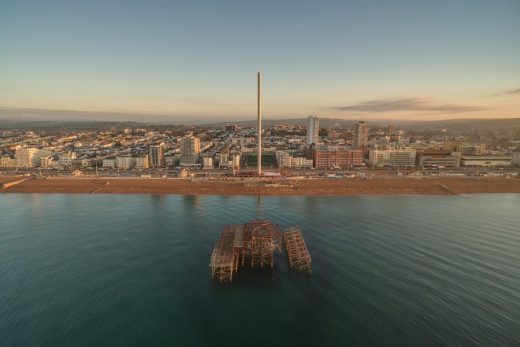
image from architects
Brighton i360
Brighton ‘Birdcage’ Bandstand
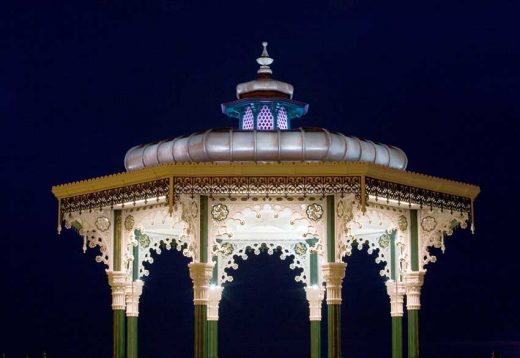
photo : Richard Rowland
Brighton Birdcage Bandstand
Architecture in England
Contemporary Architecture in England
Art Deco Architecture + Modern Architecture
Celebrated 20th Century Sussex building on e-architect:
De La Warr Pavilion, East Sussex
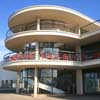
photo © Keepclicking
Key Buildings in the area:
East Beach café, West Sussex
Design: Heatherwick Studio
Littlehampton Building
Chichester Regional Museum
Design: Keith Williams Architects
Chichester District Museum
Royal Alexandra Hospital Brighton
Comments / photos for the Brighton Architecture Tour page welcome
Website: Brighton

